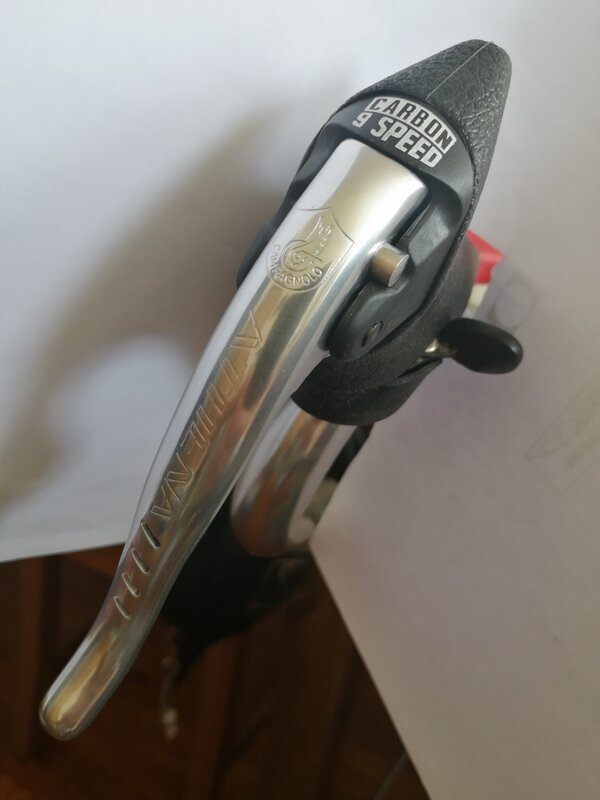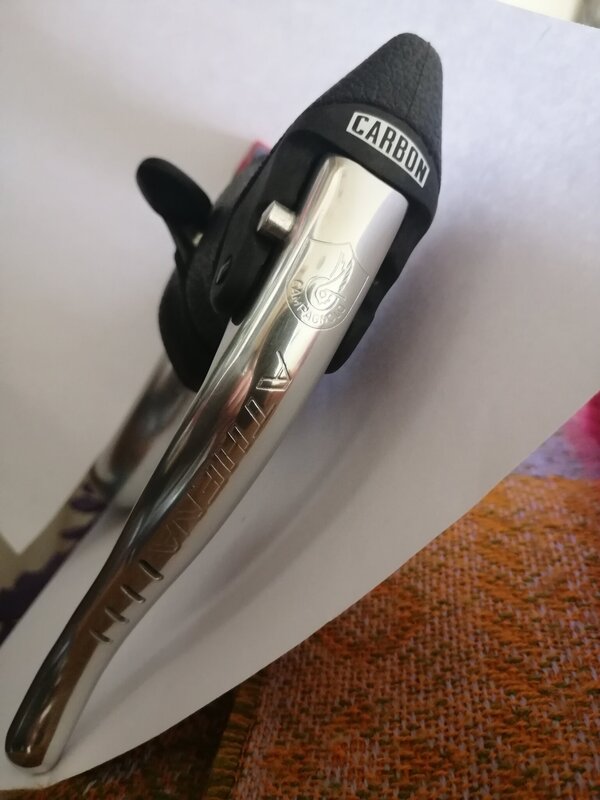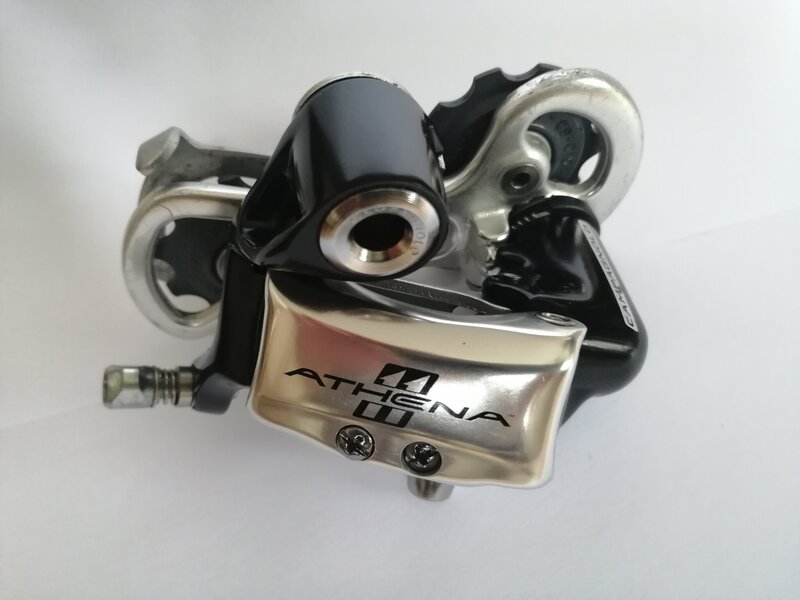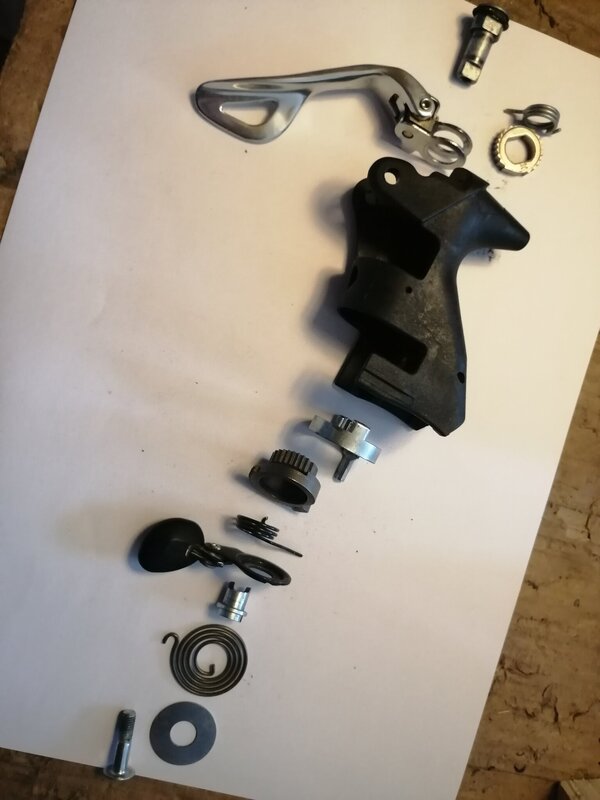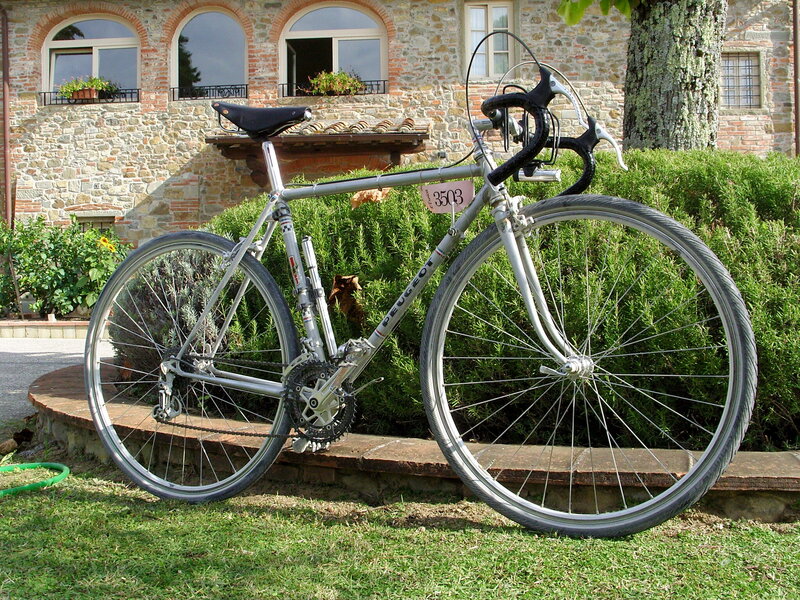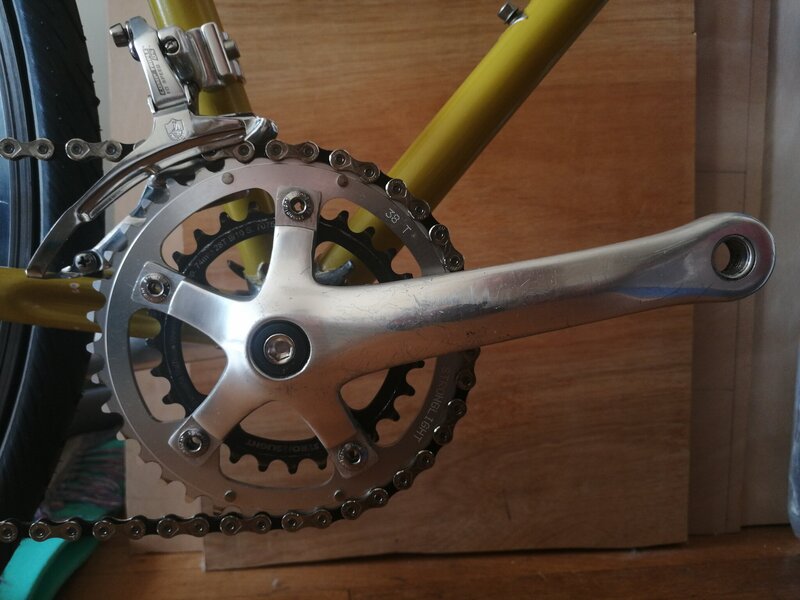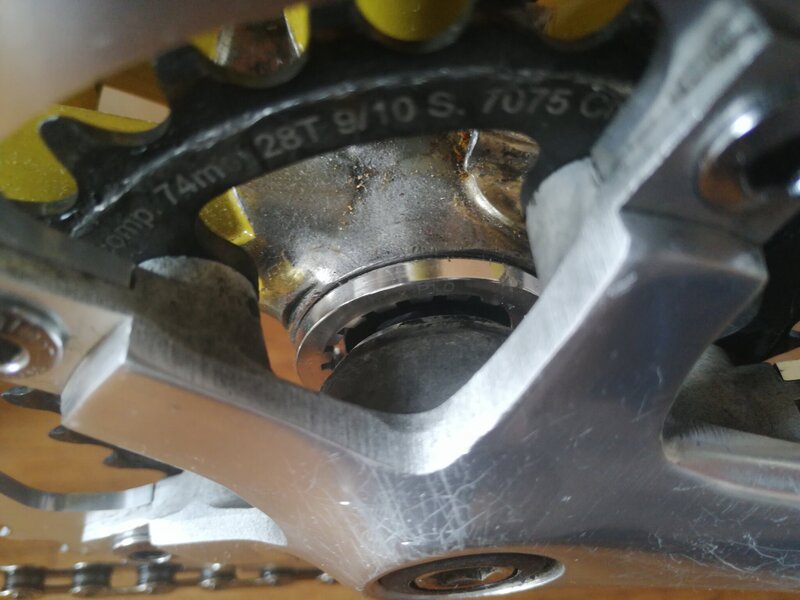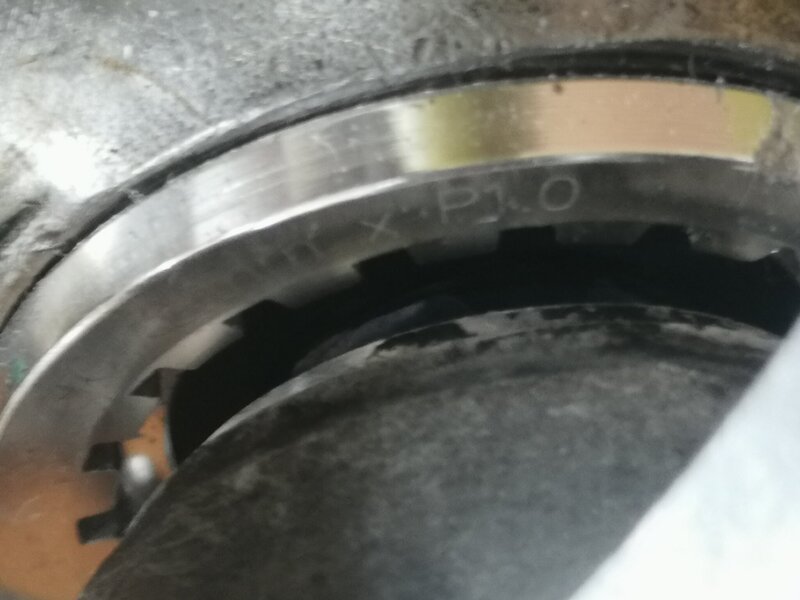You are using an out of date browser. It may not display this or other websites correctly.
You should upgrade or use an alternative browser.
You should upgrade or use an alternative browser.
1960 Peugeot PX10... Gravster!
- Thread starter zidortri
- Start date
And now, the "piece de résistance"... the drivetrain.
As mentioned at the beginning of this thread, this project aims at building a relatively modern gravel bike.
And that obviously induces a combined gear shifting and braking system - i.e. Campagnolo ergo or Shimano STI levers.
I am not fond of Shimano aesthetic and even within the Campagnolo range I have a sweet spot for the ergo levers that were manufactured between 1993 and 1999 - the "pointy" ones, often referred to as the first generation ergo levers.
Although technically they were already the second generation as the first generation of ergo levers consisted of the alloy body models manufactured between 1991 and 1993.
Enough with that semantic digression...
So the shifters that will be used for this project will be these 1999 Campagnolo Athena 9-speed ergo levers.
As mentioned at the beginning of this thread, this project aims at building a relatively modern gravel bike.
And that obviously induces a combined gear shifting and braking system - i.e. Campagnolo ergo or Shimano STI levers.
I am not fond of Shimano aesthetic and even within the Campagnolo range I have a sweet spot for the ergo levers that were manufactured between 1993 and 1999 - the "pointy" ones, often referred to as the first generation ergo levers.
Although technically they were already the second generation as the first generation of ergo levers consisted of the alloy body models manufactured between 1991 and 1993.
Enough with that semantic digression...
So the shifters that will be used for this project will be these 1999 Campagnolo Athena 9-speed ergo levers.
Attachments
Last edited:
Sorry for the poor quality of the pictures but quite extraordinarily I forgot to take a simple picture of the levers prior to fitting them on the handlebar...
And that might have been caused by my mind being fully absorbed and focused on the modifications I had to perform on these levers prior to fitting them.
Indeed although a 9-speed drivetrain is more than enough to provide a very decent gear ratio range for a regular rider - even on a gravel bike, the real issue with a Campagnolo 9-speed drivetrain lies in the limited rear mech chain wrap. That is the maximum teeth gap the rear mech can cope with and which represents the sum of the teeth difference between the largest and the smallest chainring plus the teeth difference between the largest and smallest cogs.
For a 9-speed drivetrain using a rear mech with a standard cage - i.e. a short cage, that chain wrap is 26 teeth
That is too small to allow a comfortable and hassle free usage of any cog and chainring combination.
It is only with the advent of the 2009 Campagnolo 11-Speed rear mechs that the tooth wrap was increased to 31 teeth. And that provides enough margin to safely shift gears in any possible combination... and with great peace of mind.
The 2009 11-speed rear mechs have the same cinematic as the 2000-2008 10-speed rear mechs, which results in these two ranges of rear derailleurs to be fully compatible with any 2000-2012 10-speed and 11-speed drivetrain.
And that might have been caused by my mind being fully absorbed and focused on the modifications I had to perform on these levers prior to fitting them.
Indeed although a 9-speed drivetrain is more than enough to provide a very decent gear ratio range for a regular rider - even on a gravel bike, the real issue with a Campagnolo 9-speed drivetrain lies in the limited rear mech chain wrap. That is the maximum teeth gap the rear mech can cope with and which represents the sum of the teeth difference between the largest and the smallest chainring plus the teeth difference between the largest and smallest cogs.
For a 9-speed drivetrain using a rear mech with a standard cage - i.e. a short cage, that chain wrap is 26 teeth
That is too small to allow a comfortable and hassle free usage of any cog and chainring combination.
It is only with the advent of the 2009 Campagnolo 11-Speed rear mechs that the tooth wrap was increased to 31 teeth. And that provides enough margin to safely shift gears in any possible combination... and with great peace of mind.
The 2009 11-speed rear mechs have the same cinematic as the 2000-2008 10-speed rear mechs, which results in these two ranges of rear derailleurs to be fully compatible with any 2000-2012 10-speed and 11-speed drivetrain.
Attachments
Last edited:
However these 2000-2012 10-speed and 11-speed rear mechs have a different cinematic to the 1993-1999 8-speed and 9-speed rear mech.
Therefore they cannot be swapped. And I could not use a 31-tooth wrap Campagnolo 11-Speed rear mech with a 1999 Campagnolo Athena 9-speed ergo levers.
Well that was until the 9-speed Athena ergo lever got modified into a 10-speed ergo lever.
The internet is full of resources on how to carry out such upgrade from 9-speed (or even 8-speed) to 10-speed. It's not complex and with a bit of patience and curiosity anyone can do it.
Basically most parts are identical on all ergo levers from 1993 to 2008 and even more so with the BB System ergo levers from 1996. You will just need to replace a few parts of your original ergo levers with those collected from a 2000-2008 10-speed ergo levers.
There are a few variations actually based on your original ergo lever specs - with or without central ball bearings (BB System), with or without a third coil spring, etc.. But the key principles remain the same.
If you are interested in upgrading your 8 or 9-speed ergo levers to a 10-speed set-up, and would like to give it a go I would advise you first have a look at the following thread:
https://forums.thepaceline.net/showthread.php?t=250411
The parts that need to be replaced are all listed with their reference numbers.
You could also download and print the Campagnolo spare part catalogues from the relevant year for your 8-speed or 9-speed ergo levers as well as the 2008 catalogue for the parts to be collected. That will provide visual clarity on the internal mechanics and especially the parts that need replacing.
Campagnolo spare part catalogues are available on Campagnolo official website:
https://www.campagnolo.com/NL/en/Support/download
You could also have a look at the 2008 ergo disassembly tutorial:
But basically here is how it looks once everything is disassembled with the new 10-speed parts prior to reassembling.
Therefore they cannot be swapped. And I could not use a 31-tooth wrap Campagnolo 11-Speed rear mech with a 1999 Campagnolo Athena 9-speed ergo levers.
Well that was until the 9-speed Athena ergo lever got modified into a 10-speed ergo lever.
The internet is full of resources on how to carry out such upgrade from 9-speed (or even 8-speed) to 10-speed. It's not complex and with a bit of patience and curiosity anyone can do it.
Basically most parts are identical on all ergo levers from 1993 to 2008 and even more so with the BB System ergo levers from 1996. You will just need to replace a few parts of your original ergo levers with those collected from a 2000-2008 10-speed ergo levers.
There are a few variations actually based on your original ergo lever specs - with or without central ball bearings (BB System), with or without a third coil spring, etc.. But the key principles remain the same.
If you are interested in upgrading your 8 or 9-speed ergo levers to a 10-speed set-up, and would like to give it a go I would advise you first have a look at the following thread:
https://forums.thepaceline.net/showthread.php?t=250411
The parts that need to be replaced are all listed with their reference numbers.
You could also download and print the Campagnolo spare part catalogues from the relevant year for your 8-speed or 9-speed ergo levers as well as the 2008 catalogue for the parts to be collected. That will provide visual clarity on the internal mechanics and especially the parts that need replacing.
Campagnolo spare part catalogues are available on Campagnolo official website:
https://www.campagnolo.com/NL/en/Support/download
You could also have a look at the 2008 ergo disassembly tutorial:
But basically here is how it looks once everything is disassembled with the new 10-speed parts prior to reassembling.
Attachments
Last edited:
Bonjour friend.
I think Retrobike can be credited with starting a new trend of giving French bikes a new life on gravel. (probably Mickeyspinn's idea originally)
3 possible solutions to your problem:
1) Fit an oversized carbon fibre cage onto this mech.
2) Use a Shimergo set-up. You'll probably be limited to 8 speeds thought.
3) Use Shimergo set-up and stick an oversized carbon cage onto it, because why not
I think Retrobike can be credited with starting a new trend of giving French bikes a new life on gravel. (probably Mickeyspinn's idea originally)
3 possible solutions to your problem:
1) Fit an oversized carbon fibre cage onto this mech.
2) Use a Shimergo set-up. You'll probably be limited to 8 speeds thought.
3) Use Shimergo set-up and stick an oversized carbon cage onto it, because why not
Bonjour friend.
I think Retrobike can be credited with starting a new trend of giving French bikes a new life on gravel. (probably Mickeyspinn's idea originally)
Great to see that we have a trend here
Actually this is my second vintage Peugeot gravel bike. I built my first one almost a decade ago for Eroica 2014. As the rules require strict pre-1987 setup it was fitted with standard downtube gear shifters... Although all the componentry was from Campy
Here it is...
Attachments
3 possible solutions to your problem:
1) Fit an oversized carbon fibre cage onto this mech.
2) Use a Shimergo set-up. You'll probably be limited to 8 speeds thought.
3) Use Shimergo set-up and stick an oversized carbon cage onto it, because why not
With regards to the drivetrain I am really keen on using Campy components... I just like their aesthetic.
Actually I should add - in order to be specific and consistent, that I am not fond of their more recent carbon production... To say the very least.
The nice thing with these Campagnolo kit from the 90s and even 2000s to an extent is that they retain a flair "une sorte de je ne sais quoi" of the 80s, 70s or even 60s. And that's probably the reason I stick to these.
As for the oversized carbon cage I have not seriously explored that avenue, as I could not even sawp an 8-speed or 9-speed regular size Record derailleur cage with a longer Racing cage... Not the same fitting design.
Also I now have quite a decent stock of Campy parts and I tend to streamline that stock around 10-speed compatibility in order to have enough options and spare parts for my future (and current) projects.
Last edited:
The third part after the ergo lever and the rear mech was the crankset.
A long time ago I was using a Stronglight triple compact crankset - that had a 110bcd for the large and middle rings and a 74bcd for the granny.
It was fitted onto a Stronglight 107mm JIS titanium spindle.
As the spindle proved to be too short for a triple crankset I had the basis of the spider crank milled to prevent it from rubbing against the cups.
This worked fine... ish. It never really worked well mainly because it was a triple crankset and when used in a reasonably competitive way - shifting whilst applying a lot of torque without paying much care on the chain line, it would almost invariably derailed.
This is how I understood the marvel of a double compact crankset... And the beauty of a 29t cog!
Anyway in spite of this I kept that 110/74 triple crankset feeling that one day or another I could make it to good use...
And recently I realized that it was no longer shameful to talk about "super compact" crankset... And decided to build my own, reusing my old 110/74 crankset.
But this time it would be limited to two chainrings - a 28t granny and a 38t middle ring.
Well actually before formalizing (accepting?) this 38/28t combination I had set my mind on a 36t/27t combination using Rotor Q rings - those are oval chainrings...
This Q ring combination with the extreme chainline induced by the use of a 107mm spindle on a triple crankset resulted in a impossible setup.
Just impossible.
The chainline would make it impossible to cross the chain between the small ring and the two smallest cogs - when testing this setup on a bench, one could feel that either the chain or the cage was about to give in...
In addition the chain would always be rubbing the internal sides of the front mech cage... Or would shift overboard. Or between the rings!
Well eventually I had to admit that a 107mm spindle with a triple crankset with Rotor Q rings would simply never work.
That's how I reversed to a more conventional setup with perfectly round 38/28t chainrings... whilst still keeping the 110/74 crankset and 107mm spindle.
Below are a few pictures showing how tight is the gap between the crankset and the bottom bracket cup... Mainly due to a very short spindle.
With a closer look on the crank basis one can see that the edge has been milled to avoid the crank rubbing against the cup.
A long time ago I was using a Stronglight triple compact crankset - that had a 110bcd for the large and middle rings and a 74bcd for the granny.
It was fitted onto a Stronglight 107mm JIS titanium spindle.
As the spindle proved to be too short for a triple crankset I had the basis of the spider crank milled to prevent it from rubbing against the cups.
This worked fine... ish. It never really worked well mainly because it was a triple crankset and when used in a reasonably competitive way - shifting whilst applying a lot of torque without paying much care on the chain line, it would almost invariably derailed.
This is how I understood the marvel of a double compact crankset... And the beauty of a 29t cog!
Anyway in spite of this I kept that 110/74 triple crankset feeling that one day or another I could make it to good use...
And recently I realized that it was no longer shameful to talk about "super compact" crankset... And decided to build my own, reusing my old 110/74 crankset.
But this time it would be limited to two chainrings - a 28t granny and a 38t middle ring.
Well actually before formalizing (accepting?) this 38/28t combination I had set my mind on a 36t/27t combination using Rotor Q rings - those are oval chainrings...
This Q ring combination with the extreme chainline induced by the use of a 107mm spindle on a triple crankset resulted in a impossible setup.
Just impossible.
The chainline would make it impossible to cross the chain between the small ring and the two smallest cogs - when testing this setup on a bench, one could feel that either the chain or the cage was about to give in...
In addition the chain would always be rubbing the internal sides of the front mech cage... Or would shift overboard. Or between the rings!
Well eventually I had to admit that a 107mm spindle with a triple crankset with Rotor Q rings would simply never work.
That's how I reversed to a more conventional setup with perfectly round 38/28t chainrings... whilst still keeping the 110/74 crankset and 107mm spindle.
Below are a few pictures showing how tight is the gap between the crankset and the bottom bracket cup... Mainly due to a very short spindle.
With a closer look on the crank basis one can see that the edge has been milled to avoid the crank rubbing against the cup.
Attachments
Last edited:
I see. Campy parts sure have a good polish on them.
I love campy shifters.
...And run them with Shimmy rear mechs and SRAM PG990 cassettes.
PS I used to think Campy was all about polish and status symbols, but I've changed my opinion about them when I saw the insides of a 1960s campy hub that was on a commuter bike kept for years outside in the rain. The wheel was whacked by a car while the bike was parked.
The wheel was a write-off, the forks were a write off. The hub's axle was still perfectly true, and the hub turned like it was new, despite the huge mileage and horrible storage conditions. That's some quality.
I love campy shifters.
...And run them with Shimmy rear mechs and SRAM PG990 cassettes.
PS I used to think Campy was all about polish and status symbols, but I've changed my opinion about them when I saw the insides of a 1960s campy hub that was on a commuter bike kept for years outside in the rain. The wheel was whacked by a car while the bike was parked.
The wheel was a write-off, the forks were a write off. The hub's axle was still perfectly true, and the hub turned like it was new, despite the huge mileage and horrible storage conditions. That's some quality.
Last edited:
PS I used to think Campy was all about polish and status symbols, but I've changed my opinion about them when I saw the insides of a 1960s campy hub that was on a commuter bike kept for years outside in the rain. The wheel was whacked by a car while the bike was parked.
The wheel was a write-off, the forks were a write off. The hub's axle was still perfectly true, and the hub turned like it was new, despite the huge mileage and horrible storage conditions. That's some quality.
Indeed - old Campy build quality was impressive.
The same goes for those 1993-2008 ergo shifters. I have disassembled, restored - that is essentially removing the grease/dust hard mix and applying some grease, rarely changed a part (spring mainly), and reassembled those shifters and they work just as well as on day one. Parts are easily available, servicing is straightforward and changing the speed count is just a no brainer.
Unfortunately that does no longer hold true for the latest iterations... mere plastic. Maybe it makes sense from a business standpoint - no need to keep a stock with a great variety of spares, just a couple of nearly complete ergo bodies, no extensive labour involved when swapping those bodies as opposed to a couple of hours required when disassembling, cleaning, ordering a couple of parts, waiting for these parts, reassembling, etc...
Those newest plasticky ergo levers work well - there's no denying. But the difference between these new 11, 12 and now 13-speed levers and the 8, 9 and 10-speed ones is akin to the difference between a smart watch and a Jaeger-LeCoultre.
Last edited:
Similar threads
- Replies
- 9
- Views
- 3K
- Locked
- Replies
- 147
- Views
- 27K
- Replies
- 59
- Views
- 14K
